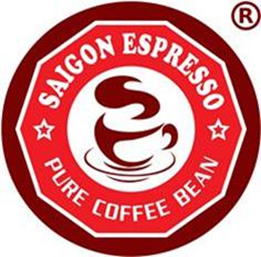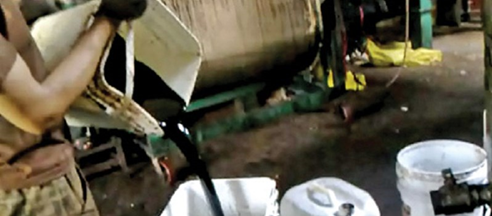Mixing anti-malaria antibiotics for strong aromatic coffee Never before, Vietnamese people have the habit of drinking a cup of coffee that must be strong, bitter, comparable, foamy, fragrant and cheap, and, coffee shop owners Is this custom, or is the taste above the default by the coffee maker?

There are quite a few words to name a type of coffee with “very little or no coffee”: fake coffee, fake coffee, corn coffee, chemicals, dirty coffee… but in short, the very name shows the ways. The method of making finished coffee is rampant on the market today.
Bitter with corn – soybeans – quinine
Talking to us- three owners of finished coffee shops, two in Saigon and one in Ban Me Thuot- each gave a few “secrets” to making coffee-no-coffee, ie. , no need for raw coffee beans, there is still coffee powder or beans (roasted and impregnated).
There are things in common, all three of these establishments are participating in the market of producing and supplying so-called “clean” or “pure” coffee, and the owners regularly receive attractive offers from coffee makers. Trading powdered coffee: supplying raw materials (corn, soybeans, chemicals), product consumption 4-5 tons/month, attractive profit.
Mr. Dat, the owner of the establishment in Ban Me Thuot said that there are many ways to create bitterness for fake coffee. The rumor about using quinine (quinine – an antibiotic that cures malaria) mixed into coffee to create bitterness is just one way.
Because it takes 0.15 kg of caramel to turn one kilogram of corn and soybeans into coffee. Caramel, in addition to the function of color and taste, also to overpower the smell of beans and corn. Plus mix cheap Chinese chemical sugar. At this time, the coffee will be very sweet, so it is necessary to use kilograms to balance the taste because it is very bitter. Or, you can replace it with some commercially available bitter chemicals.
Another establishment owner in Saigon, who requested anonymity, added that Ky Ninh is just one of a chain of spices to produce fake coffee. To create fat, they use industrial butter, to concentrate use a substance called CNC (a chemical used in the curing process), a foaming agent used in the production of detergent soaps, a fragrance agent (milk , cocoa, coffee)…
All of them are not of Chinese origin or origin, and are openly sold at Kim Bien market, district 5. Many fake coffee production establishments are ordered to provide corn, beans and an 18-liter can of mixed coffee. chemicals already mixed (price 3 million dong). This chemical can brew 1 ton of powdered coffee.
Without those substances, corn and soybeans can never be turned into coffee. Investing in fake coffee processing technology in small establishments only costs a few tens of millions of dong: a pan to roast corn, soybeans, a mill for seven million, a day will get a few hundred kilograms of coffee.

It’s fake over the price
Selling one kilogram of powdered coffee, Mr. Tran Van Ngai – who specializes in dispensing coffee for a weasel coffee establishment in Tan Phu district – earns 15,000 VND. The owner’s price is 45,000 VND/kg, he sells 60,000 VND/kg. This is the common price of a kilogram of coffee being used by many coffee shops and Mr. Ngai still thinks that this is real coffee.
Mr. Dat gave the formula: to make a kg of real coffee takes from 1.6 – 1.8 kg of raw coffee beans, the current price of the cheapest type (bean length more than 5mm) is also nearly 40,000 VND/kg. Plus the cost of roasting, packaging, shipping…, and even though tax is smuggled, a kilo of finished coffee is already at between 100 and 110 thousand VND. A little below this level is a blend (addition of corn, beans) and below that is no coffee.
Last year, the owner of a coffee chain roasted and ground on site in Saigon shared the same opinion that many establishments are selling powdered coffee for 45-60 thousand/kg with a commission of 15-20%, just coffee. dirty (chemically impregnated cereal flour). To make a kilogram of cheap pure coffee (beans), the cost has been up to about 120,000 VND (including: price of raw materials, loss rate when roasting 30-40%, processing cost 10%, 20% distribution…).
In contrast, according to Mr. Dat, the cost for a kilogram of fake coffee is about 30,000 VND. If roasting about 700g of soybeans, 500g of corn, 100g of coffee beans (if not coffee, increase soybeans) plus chemicals will get 1kg of powdered coffee. With a price of 45 – 60 thousand VND/kg, this type of coffee is easier to sell – a competitive advantage – compared to real coffee. Of course, from the manufacturer to the distributor makes more profit.
Quality drift
Dak Lak is considered the “capital” of Vietnam’s coffee, but in a “sweep” of fake coffee in early 2013, the specialized inspection agency of the Department of Agriculture and Rural Development in this province checked. inspected and discovered 14 powdered coffee production and processing establishments in the province that did not meet the quality standards as announced.
The caffeine content in most of the tested product samples was only 0 – 0.47%, too low compared to the minimum standard standard of 1% or more. Among them, there are names of many establishments producing powdered coffee being drunk by Saigon people, such as: Thanh Thuy, Y Viet, Nguyen Lam, Me Viet, Dat Viet…
Until now, coffee quality control by law simply regulated the amount of caffeine (how much in a product weight) without regard to origin or processing. Not to mention, the inspection and control, if any, only occurs at the establishments producing finished coffee sold on the market. As for coffee in the beverage market, it belongs to the units that inspect food hygiene and safety. But these units do not have the ability to check the quality of coffee, especially unable to check hundreds of thousands of coffee shops in every corner.
Dak Lak is considered the “capital” of Vietnam’s coffee, but in a “sweep” of fake coffee in early 2013, the specialized inspection agency of the Department of Agriculture and Rural Development in this province checked. inspected and discovered 14 powdered coffee production and processing establishments in the province that did not meet the quality standards as announced.
On the other hand, for a long time, the management, inspection, recognition or sanctioning of food-related products have been presided over by the Food Safety and Hygiene Department of the province. Units such as market managers, industry inspectors, etc. only participate when setting up an interdisciplinary inspection team.
It was not until 2012 that the function of quality control and inspection for agro-forestry-fishery products was assigned to the Quality Management Department of the agriculture and rural development sector.
The process is roughly as follows: coffee beans (and other agricultural products) from the garden to the place of roasting, processing, and putting into the mouth is the responsibility of the agricultural industry. From the place of processing to the market is managed by industry and trade. When it comes to the mouth belongs to the medical profession.
But can all these stitches and agencies, with a lot of overlap and confusion, be able to control fake coffee? The answer lies in the quality of finished coffee on the market, a drink that is not only a refreshment but most Vietnamese are fascinated and ignorant.
Is it necessary to soon force the coffee shop to announce the origin, quality and ingredients of the coffee they are preparing, and at the same time, the finished coffee production facilities must register the quality of food hygiene and safety? and subject to regular control checks? That is the way to protect consumer health and is a question for regulators.
Sourece: Nguoi Do Thi

